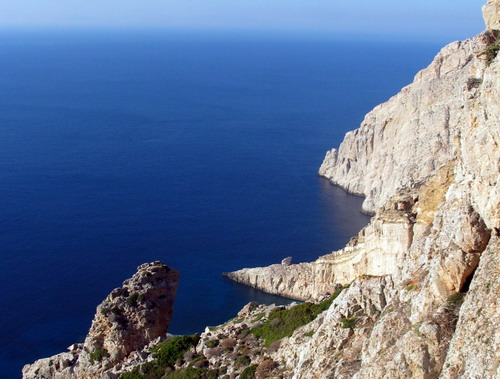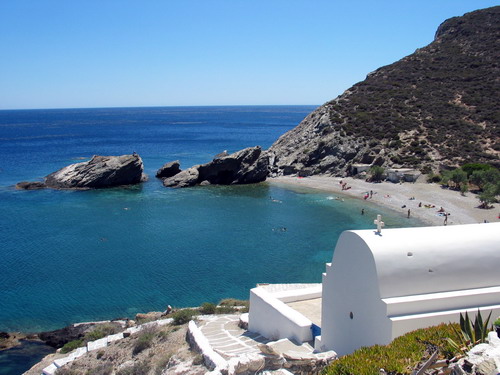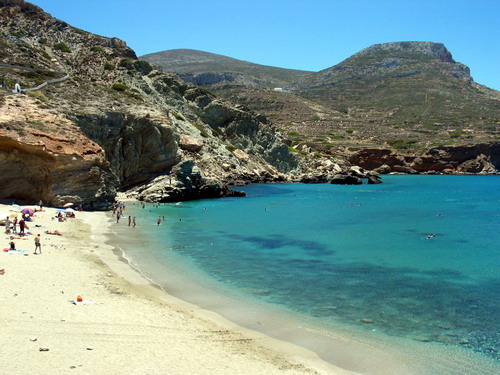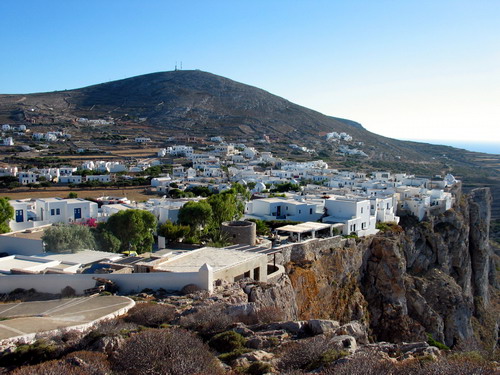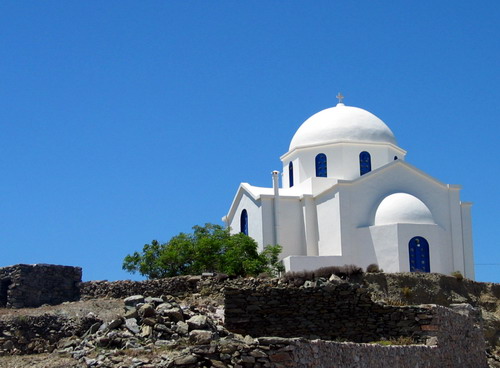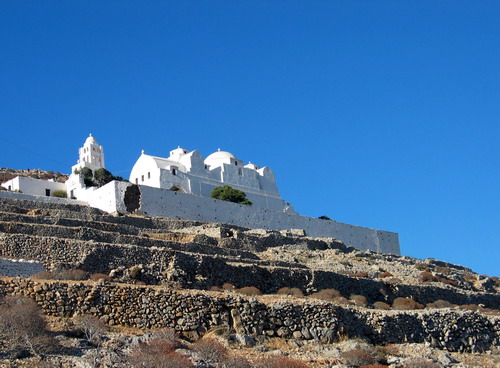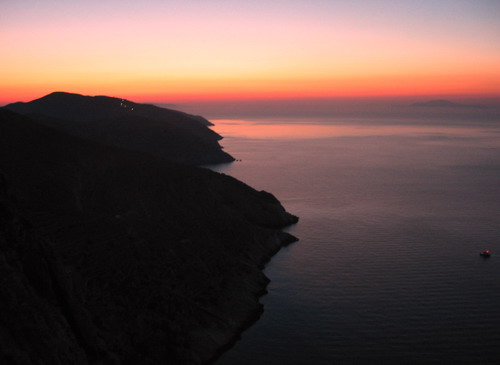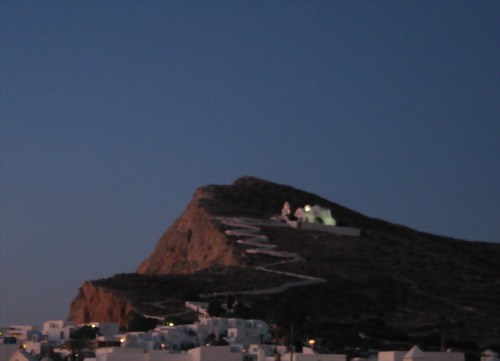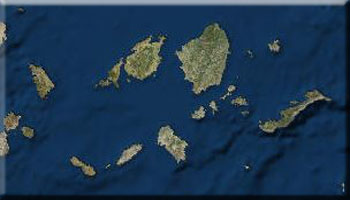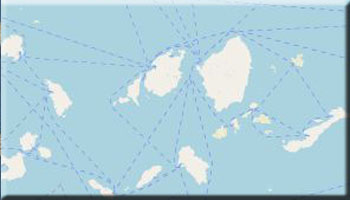Folegandros is an island of moderation. The gradual development of tourism over the last two decades has allowed the island to retain its traditional features while introducing modern amenities and organized tourist services.
Folegandros is just 104 nautical miles from Piraeus. During the peak season there are four sailings per week, and the journey lasts nine hours on the Western Cyclades ferry route (twice weekly) and eleven hours on the Eastern Cyclades ferry routes (twice weekly).
The island's main settlements are Hora, Ano Meria, the port village of Karavostasis, and the resort of Agali. There are secondary settlements at Livadi and Petousi. Administratively the island comes under the Thira Eparchy of the Cyclades prefecture.
Following arrival at Karavostasis, visitors are immediately drawn to the narrow lanes of Hora and from there to exploring the passages of Kastro, the old fortified settlement, and the Panayia Promontory with its panoramic view over the Aegean. Next on the itinerary is swimming at either the island's secluded beaches or its more popular ones and exploring the island via a network of footpaths. Home cooking offered in all tavernas is also considered an attraction.
Hora, built on a plateau about 200 meters above sea level and about 3.5 kilometers from Karavostasis, preserves its vernacular architecture. Stone-paved lanes, a number of neighborhood squares, and the old fortified settlement of Kastro are themselves attractions. Taking in the view from Kastro's northern side on Pounta square, lazy afternoons in the shaded Dounavis square, and the lively night-time atmosphere in Piazza comprise the memorable experiences of a holiday on Folegandros.
Karavostasis, the port, is a tranquil settlement, ideal for swimming and relaxation.
The Phoenician word "phelekgundari" means rocky land and is one of the possible roots of Folegandros's name. By another account, the island is named after its first inhabitant, Folegandros, a son of the King Minos of Crete. Under Venetian rule, the island's official name became "Polykandros".
After the fall of Constantinople in 1204 and the emergence of Venice as the supreme power in the Aegean, Venetians and Turks sought to seize control of the island.
In 1715, Folegandros fell to the Turks. It was united with Greece in 1828.
During the Metaxas dictatorship, Folegandros became a place of internal exile, much as it had been during Roman rule.
Panayia: Panayia, the island's most important church, is dedicated to the Dormition of the Virgin. It perches on a rocky face over Hora and was built on the site of an ancient temple; ancient epigraphs and statue bases can be seen in the court and inside the church. Panayia is a single-aisle, multiple-domed church basilica with a tall steeple. It was renovated in 1687, according to a marble inscription, and took its present form during restorations conducted from 1816 to 1821. A marble iconostasis, the bishop's throne, and the pulpit are the works of the noted Tinos sculptor Kaparias. A Byzantine-era icon of the Virgin, said to be endowed with miraculous powers, is housed within the church and is mentioned in island lore and pirate tales. Panayia is reached via a cobblestone path from Pounta square after a roughly 15-minute walk.
Kastro: Hora's old town comprises a medieval fortified settlement. The northern side is built at the edge of a sheer cliff, 210 meters above the sea. The homes, many more than ten centuries old, are all inhabited and in good condition. Kastro has been declared under historical preservation and is under the purview of the local department of the Archaeological Service.
Ethnographic Museum: The island's Ethnographic Museum is housed in a 19th-century farmhouse, or themonia, in Ano Meria. Exhibits recreate a typical farm household such as those that existed on the island through the mid-20th century. The museum is run by the Folegandros Cultural Society and is open during the summer from 5 to 8 p.m. daily.
Chrysospilia: Chrysospilia, an unexplored cave, is an impressive natural monument located on the island's northeastern coast, about 10 meters over the sea. Human remains, shards, and a Roman reservoir have been uncovered inside. The cave was used for cult worship and coming-of-age rituals in the fourth century B.C. It's accessible by sea only in calm seas, and special permission is required to visit the site.
Aspropounta Lighthouse: The lighthouse was built in 1919, about 58 meters above the sea; it stands 11 meters high. Aspropounta's beam is visible at a distance of 17 nautical miles. When first built, it was lit by wick and later by a mechanism powered by oil and steam. Since 1986 it has been solar-powered. The lighthouse can be reached on foot from Livadaki, about 15 minutes, or from Pano Meria.
Hohlidia - Vardia - Katergo - Livadi - Agali - Ayios Nikolaos - Livadaki - Ampeli - Ayios Georgios - Voreina - Serfiotiko: At Folegandros's beaches, the scene is set by clear waters, green shingle seabed, secluded sandy coves shaded by tamarisks, and tavernas serving fresh fish by the water. Beaches are accessible by fishing boat, car, or bus, while the more secluded beaches are best reached on foot. Folegandros is an ideal destination for walks and hikes thanks to an extensive network of footpaths framed by dry stone walls leading past old mills, abandoned haystacks, canyons, and remote chapels.
Karavostasis (Hohlidia): Located just off the harbor at Karavostasis, this beach extends off the settlement along the shore. Recommended for families, the beach is shaded by tamarisks and lined with bars, tavernas, and hotels. In summer, children can take swimming and sailing lessons organized by the Folegandros Nautical Club. The beach is sand and pebble, with a sand seabed. It's ideal for children as one end is quite shallow and the cove is sheltered from winds so the water is rarely choppy.
Livadi: Located on the island southeastern shore, the beach is next to a sparsely populated resort. It's reached by car from Karavostasis. Tamarisks offer shade, and there's a restaurant within the grounds of the organized camping site. The beach has fine belles and a sand seabed.
Agali: Located on the southern shore, the beach extends from a resort settlement. It's reached by bus, private vehicle, or boat from Karavostasis. Agali is a good choice for families. There are tavernas and a handful of rental rooms. The beach is fine sand with a sand seabed. Nearby is the small, sandy cove of Fyra, reachable by footpath (about 10 mins). Also nearby is Yalifos, also accessible by the footpath leading to Ayios Nikolaos; rental rooms are available but these do not have electricity.
Ayios Nikolaos: Beach on the southern shore, close to Agali in an uninhabited part of the island. It's accessible by boat from Agali or on foot - 20 minutes from Agali and 45 minutes from Ano Meria. There is no road. Tamarisks along the shore offer shade, and there's a small restaurant. The beach and seabed are sand with small pebbles.
Livadaki: Located near the Aspropounta lighthouse in an unpopulated area. It's reached by boat from Karavostasis and Agali, or on foot from Pano Meria (about 1 hour); it is not accessible by road. The beach offers little natural shade; swimmers should bring drinking water as the beach is quite remote and there has no taverna. The beach and seabed are smooth white pebble. The water is crystal clear.
Ampeli: Located on the island's northwestern shore in an uninhabited area. Access is on foot or by private boat. The footpath sets off from the Ayios Pandeleimon chapel in Pano Meria (about 30 minutes). Orchards slightly off the shore offer thick shade. Swimmers should bring drinking water. The beach and seabed are pebble and shingle.
Ayios Georgios: Located on the northeastern shore in an uninhabited area. Access is by a good dirt road, about 10 minutes from Ano Meria or by foot, after an hour's walk. Tamarisks offer shade. Swimmers should bring drinking water. The beach and seabed are sand and pebble. Nearby, there's a good beach at Lygaria.
Voreina: Located on the island's northern coast in an uninhabited area. The beach is accesible only on foot, about 20 minutes, via a footpath that sets off from the windmills off the left-hand side of the Hora - Ano Meria road. There's no natural shade and swimmers should bring drinking water. The beach and seabed are green shingle.
Serfiotiko: Located on the island's northern coast in an uninhabited area. The beach is accesible only on foot from Ano Meria, about 40 minutes. Sparse tamarisks offer a little shade. The beach and seabed are sand, pebble, and shingle.
The Folegandros Cultural Society organizes art, ceramics, and photography exhibits every summer. On nights with a full moon, concerts and poetry readings are held at the Ethnographic Museum in Ano Meria.
The Maritime Society organizes swimming and sailing races every August at Karavostasis and Agali.
In July, the Folegandros Festival hosts a number of events in Kastro, Karavostasis, and Ano Meria, including screenings, theater, and concerts featuring Greek or classical museum. Thematic exhibits are organized in the neoclassical Elementary School building throughout the summer.
The island's Easter celebrations are unique as the Panayia's icon removed from the monastery and taken in procession from home to home in a celebratory mood marked by songs and fireworks; the icon is welcomed with wine, raki, and sweets. On Easter Sunday, the icon is taken in procession around Hora and Kastro, where it's welcomed with fireworks. On Easter Monday, the icon is then taken to Ano Meria and farmhouses, while at Karavostasis it is also taken to bless fishing boats and any yachts docked there. That night, it's returned to the monastery, where it remains until the following Easter.
| COMMUNITY OF FOLEGANDROS | 2286041285 |
| CITIZENS SERVICE BUREAU (KEP) | 2286027180 |
| MEDICAL CENTRE | 2286041222 |
| PORT STATION | 2286041530 |
| POLICE STATION | 2286041249 |
| TAXI STATION (ONLY ONE) | 6944693957 |
| BUS STATION (TWO BUSES) | 6944906158 |
| POST OFFICE-POSTAL SAVINGS | 2286041299 |









